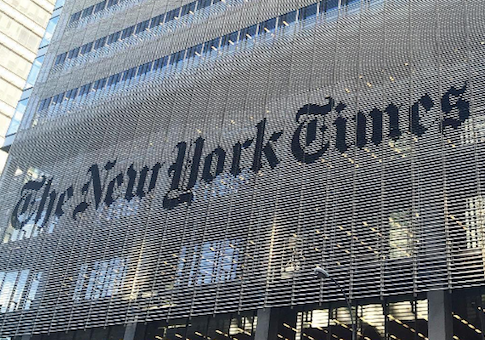President-elect Donald Trump's cabinet picks plan on moving the country "far to the right," and not just any far right but the "Israeli far right," according to the latest reports from the New York Times.
The Grey Lady introduced readers to David Friedman, Trump's nominee to serve as ambassador to Israel, with the ominous warning that he is a "hard-liner" who could "could end up undercutting the security of Israel and the United States," as one "left-leaning" expert told the Times on Dec. 15. Friedman was described in the first paragraph as a "bankruptcy lawyer aligned with the Israeli far right."
"Far right" has become a staple of the New York Times lexicon since Trump's upset victory over Hillary Clinton. The paper has used the term in connection to Trump 158 times since Election Day, tying him to everything from Europe's rising nationalist parties to a Klu Klux Klan stabbing and profiles of internet-based white nationalist trolls. The term "far left" was used in connection to President Obama, by contrast, 431 times over the past eight years.
Friedman is not the only Trump cabinet nominee who threatens the balance of American politics. On Dec. 5 the paper stated that Trump's "Cabinet Picks Portend a Shift Far to the Right." As evidence of these far right tendencies, the paper cited that many of the president-elect's nominees "have long records opposing the current administration on social programs, wages, public lands, veterans and the environment."
The Times pointed to Trump's Labor Secretary nominee, fast food restaurateur Andrew Puzder, as an example of the shift away from the center. Puzder "has been extremely critical of the Obama administration’s labor policies, including its push for a higher minimum wage and for new overtime rules for workers."
The Times does not say that the Democratic Party platform's embrace of a $15 minimum wage—more than double the current rate of $7.25—originated from one of the most liberal wings of the party: union powerhouse Service Employees International Union. On Nov. 22, a federal judge appointed by Obama blocked the new overtime rules because they are "contrary to the statutory text and Congress’s intent" of the Fair Labor Standards Act. The article does not say if the Obama administration's policies—such as his efforts to "shut down fossil fuel production"—constitute a turn to the "far left."
Trump's nominees stand in stark contrast to those of President Obama, who according to the New York Times has never nominated anyone from the far left to a cabinet position or federal court. Dating back to Obama's Nov. 4, 2008 election victory, the Times has used the word "far left" to describe "nominee" in about 140 instances, according to Lexis Nexis. The use of the term was more likely to help readers navigate photo captions—82 times—than provide context about a politician or prospective Democratic cabinet member's political leanings. The Times obituary of communist dictator Fidel Castro, for example, employed the phrase just once: "REVOLUTIONARY: Far left, Fidel Castro in 1968."
The rare appearance of "far left" in the New York Times typically comes in the form of a quote from Republican politicians, rather than a news or headline writer's copy. The paper's journalists work hard to provide important context for its readers. When New Jersey Republican Steven Lonegan called now-Sen. Corey Booker "a far left liberal extremist," Times reporters added that Booker "is frequently criticized in his own party for his moderate views."
The paper used "far left" twice while covering the nomination of now-Supreme Court Justice Elena Kagan. When she cleared the Senate Judiciary Committee on a near party-line vote—Sen. Lindsey Graham was the only Republican to vote for her—the Times reported that "Senator Charles E. Grassley, Republican of Iowa, complained of Ms. Kagan's 'strong commitment to far left ideological beliefs.'"
Grassley would have known more about Ms. Kagan had he read the June 18, 2010 edition of the New York Times, which featured a 2,500-word profile of her roots titled, "The Kagan Family, Left Leaning and Outspoken." Readers discovered that she came from a "New York family whose intellectual dynamism and embrace of liberal causes provide a window onto the social milieu and culture that shaped her." Her father tied himself to a tree once; her brother's "involvement in radical causes' [was] an inspiration for her senior thesis on the Socialist movement in New York."
Far left appears in the article one time: "TOUGH TEACHER: Elena Kagan's mother, Gloria, far left, with her class at Hunter College Elementary in 1979."
Kagan now has a more leftwing record on the court than liberal icon Ruth Bader Ginsburg, according to the Washington University School of Law's Supreme Court Database.
